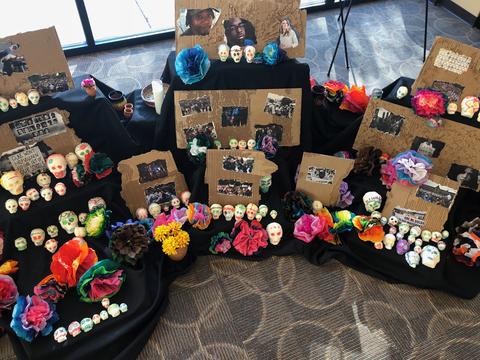
Connecting Art, Culture, and Social Justice

Every country honors the dead in some way. In Mexico, Día de los Muertos (Day of the Dead) is marked by two days (November 1 and 2) of celebrating the lives of deceased loved ones with food, drink, parades, dancing, visits to gravesites, and the creation of special altars. Decorated with paper flowers, food, candles and other items, these altars, or ofrendas, are not created for worship but rather as a place for nourishing the souls of the dead.
Those who visited the gallery of the University of Minnesota’s Urban Research and Outreach-Engagement Center (UROC) in November of 2018 had a unique opportunity to see a Día de los Muertos community altar that was created by a group of students from Minneapolis’ Roosevelt High School. Installed in the gallery for just a few weeks, the altar was dedicated to innocent people who have lost their lives in school shootings and at the hands of police.
Roosevelt High School World Language Teacher Estela S. Lerma led the project, which was part of a broader examination of Hispanic and American cultural traditions by the students in her Spanish class. In addition to photographs of some of those who were killed, including Justine Damond, Jamar Clark, and Philando Castile, the altar included artwork by students such as paper flowers and skulls, as well as poems written in English and Spanish. “The project integrates art, culture, and social justice while also promoting literacy,” Lerma says, explaining that the community altar not only honors the dead, it also helps raise awareness about important issues.
“There were some students in my class who weren’t aware of Philando Castile’s death and some of the other shootings, and I think it’s important for them to know about these things,” she says. “I teach Spanish, but at the same time I help make students aware of what’s happening in the world outside of academia. That’s an important part of their growth too.”
Finding ways to blend traditional coursework with art and cultural awareness comes naturally to Lerma. Originally from Argentina where she taught language classes for many years, she earned her master’s degree in education, curriculum and instruction from the University of Minnesota and took courses at Concordia University to become a teacher of visual arts and sculpture. Her public art and sculptures have been exhibited nationally, including installations in Minnesota, Michigan, Illinois, South Dakota, and New York.
While Lerma knew it would be meaningful to her students to have their work featured in the UROC gallery, she was surprised by how much they really got out of the experience. “They liked that the installation gave them a voice,” she explains. “Projects like this just make more sense when they are connected to the public, and it meant a lot that the community got to see their work. Just in the time the installation was up, there were several more mass shootings. If we do this again, I think we’ll include a box where people can include the names of loved ones or comments they want to make because seeing altars like this can feel very personal.”